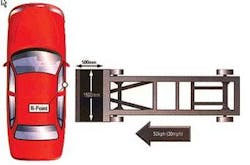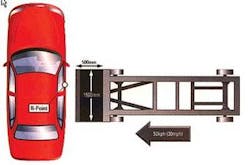Top class in EuroCrash
Laser-welded side-impact protection profiles improve safety
The ramming machine bores into the side of the new automobile at a speed of 50 km/h (see Figure 1). Sensors situated all over the test dummy signal, within a fraction of a second, details of the stress load. The overall results of the Euro-NCAP Crash test will shortly afterwards appear in all the specialized automobile magazines.
Euro-NCAP stands for European New Car Assessment Program. It was introduced in 1997 by five European governments together with the European Commission. Its results are closely followed by the general public, so much so that hardly any automobile producer today would risk ignoring them. Safety has become one of the most essential selling points, so great attention is being paid to safety-related automobile bodywork parts. At the same time, strong competition is pressuring constant research into new and more economical manufacturing concepts. The combination of profiles and laser welding can play a significant role in achieving this goal for such bodywork parts.
The side impact protection profile is made of high tensile fine-grained, galvanized steel with a thickness of 1.5 mm and a tensile strength of from 800 to 980 N/mm2. The high tensile strength of the material requires high forming forces that place a greater demand on the machine itself while, at the same time, exacting profile tolerances are demanded. The fillet of the hollow section is not easily accessible. The quality of welded seam corresponds to welding factor one. Only a CO2 laser with a 4KW output could be considered for the welding process. The laser offers great advantages, but places high precision demands on the roll-forming machine. Precise guidance of the strip metal edges, especially in the welding area, is necessary (see Figure 3).
Likewise great care must be taken during the preparation of the welding seam. The zinc layer in the welding area must be completely removed as zinc particles in the molten weld zone will cause undesired pores and spatter. A combined edge scraping and grooving device solves this problem. In the same way, welding errors can be caused by organic impurities, such as lubricants. Despite the high forming forces, excess lubricant must be avoided. Those rollers subjected to greater pressure are taken care of by a felt pad that is dosed by means of a precise electrical device, which sparingly emits the correct amount of lubricant. Thus the profile itself remains unaffected.
In order to keep the residual stress in the profile to a minimum, a so-called “descending” forming process is selected, i.e. the profile level progressively decreases as it approaches the exit. In comparison with a horizontal forming process, this allows for the stress level to be considerably reduced, resulting in higher precision of the profile. This is clearly seen especially in the automobile industry where frequent process capability testing is carried out.
Various openings in the profile (see Figure 2) provide for lacquer and rain discharge. In order to enable complete drainage, the openings must be situated as close as possible to the bending radius. This presents an especially difficult demand, as these punches are already applied to the flat metal strip and proceed through the entire forming process. Model calculations during the conception phase illustrated that punch deformation due to the forming force was to be expected. Only after displacing the punch location could the observance of the punching tolerance be ensured.
Assembly in the four vehicle doors necessitates four different profile versions with various punch and notch lengths and positions. To ensure this, a programmable roll feed device is situated in the pre-punching unit at the beginning of the production line and a flying cut-off machine, capable of programmable part lengths is situated at the end of the line. No deformation at the profile ends is accepted.
The sawing of the profiles owing to the highly expected wear and tear of the circular saw discs as well as the lengthy sawing times was out of the question. The highly demanding speed was achieved by means of cut-off punches. The fact that no deformation of the profile cross-section occurs is due to a special procedure. A notch, having the same width as the punching blade plus an additional tolerance, is pre-punched in the flat strip. Therefore the tip of the cut-off blade is not required to enter the material directly. The dangers of profile deformation are therefore eliminated. The particular shape of the punching blade as well as a suitable coating and lubrication allow for an economical tool-life.
The complete unit measures approximately 30 meters in length and is operated by only one person. Only the coil changeover and the profile removal require additional personnel. The coil changeover, thanks to the high automation, takes only three minutes. This manifests itself in the line’s excellent uptime. A particular skill in machine operation is not necessary. The operator receives instructions from the manufacturer once the machine has been installed. Even firms that have had no previous roll-forming experience are able to employ this extremely economical process.
Long before the planned delivery date, samples for both quality and reliability testing purposes must be delivered. This is only possible when the machine supplier has his own test machine available. At the same time, however, essential components of the line can be tested. Therefore most of the necessary optimization work can be carried out long before production start-up. Then the frequently short-term planned start-up of the new machine can take place without any unexpected surprises.
Should the profile one day be no longer up-to-date, that is not a problem for the machine itself, as an ingenious, quick tool changeover system allows the machine to produce numerous other profiles. This offers the profile manufacturer substantial production flexibility. Thanks to these outstanding characteristics, it is no wonder that the automobile industry has increasingly considered roll-forming processes for further bodywork parts. Last but certainly not least, safety is increased and costly labor is saved.
Werner Wasmer, werner.wasmer@dreistern. com, is vice president of Dreistern, Inc. (Telford, PA).



